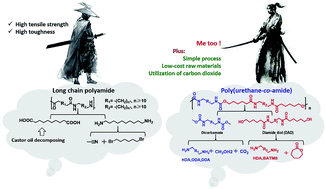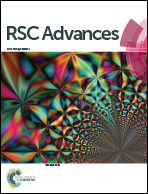High performance poly(urethane-co-amide) from CO2-based dicarbamate: an alternative to long chain polyamide†
Abstract
Due to its high strength, toughness, corrosion resistance and wear resistance, long chain polyamide (LCPA) has attracted broad interest. Nevertheless, its wide application in industrial fields is still being restricted because the starting material acquisition step involving diacid and diamine remains a major obstacle. Herein, we circumvent this obstacle by developing a novel polymer with similar properties by a green and efficient copolymerization process of carbon dioxide (CO2)-based dicarbamate with diamide diol under vacuum conditions, named poly(urethane-co-amide) (PUA). The semi-crystalline PUAs with high number-weight-average molecular weights (Mn, up to 41.3 kDa) were readily obtained, and these new polymers show high thermal stability (above 300 °C). Thanks to its unique chain structure, the amide, urethane and urea groups can endow the polymer with a high density cross-linking network via hydrogen bonds and high crystallinity that can result in high strength, up to 54.0 MPa. The dynamic thermomechanical analysis (DMA) results suggest that the phase separation exists within the new polymers, endowing the PUAs with a toughness higher than that of long chain polyamides. Consequently, this work not only develops a useful new polymer like commercial polyamides with high performance as a long chain polyamide candidate, but also provides a new way of utilizating CO2.



 Please wait while we load your content...
Please wait while we load your content...